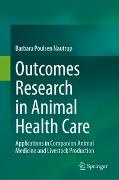Read more
This is the first book on outcomes research (OR) in animal health care, published at a time when OR is increasingly recognized in veterinary medicine. OR is an interdisciplinary field of research that evaluates the results of healthcare interventions regarding their effects relevant for patients and animal care takers.
Serving as an easy to read and comprehensive reference, this volume describes the primary areas of OR in detail. It starts with a concise overview of its outstanding development in human medicine and the current situation in animal health care for pets and livestock. The second part offers the key tools used in OR including prospective and retrospective studies and meta-analyses, illustrated with real-world examples from veterinary medicine. The following part is committed to health economic studies, the ultimate use of OR data. All relevant analyses are carefully described and explained, focusing on cost-benefit and cost-effectiveness analysis, being the most relevant analysis in livestock and companion animals. The last part is dedicated to QoL and animal welfare metrics. It outlines the current situation in veterinary medicine, covering available instruments to assess QoL in animals, their advantages, and potential pitfalls. The book concludes with presenting the groundbreaking tools from human medicine, i.e., the quality-adjusted life years (QALYs) and disability-adjusted life years (DALYs), along with early efforts to adapt these concepts to animal health care.
The multidisciplinary content addresses a broad audience, including students, veterinary practitioners, researchers, industry professionals, livestock producers, and policymakers. Further, scientists interested in QoL in animals or the development of QoL questionnaires will find helpful guidance. No specialized background in economics, epidemiology, or statistics is required.
List of contents
Part I: Introduction to Outcomes Research.- Chapter 1. Outcomes Research – Definition, History, and Applications.- Part II: Data Sources and Applications.- Chapter 2. Compliance.- Chapter 3. Primary Data Sources.- Chapter 4. Retrospective Studies.- Chapter 5. Meta-Analysis.- Part III: Health Economic Studies.- Chapter 6. Cost Data in Health Economic Studies.- Chapter 7. Non-Comparative Health Economic Studies.- Chapter 8. Cost-Minimization Analysis.- Chapter 9. Cost-Benefit Analysis.- Chapter 10. Cost-Effectiveness Analysis. - Chapter 11. Sensitivity Analysis.- Part IV: Quality of Live and Animal Welfare.- Chapter 12. Quality of Life and Animal Welfare.- Chapter 13. Quality-adjusted life years.- Chapter 14. Disability-Adjusted Life Year (DALY).
About the author
Dr. Barbara Poulsen Nautrup has graduated and worked as a veterinarian in clinics and the pharmaceutical industry before she specialized in outcomes research, health economics and pharmacoeconomics, proven by a Master’s degree, granted by the University Pompeu Fabra, Barcelona, Spain. She has been working for many years as a consultant, supporting outcomes research in animal health care. Her long professional career in health economics and outcomes research in veterinary medicine is verified by a long list of conference presentations and articles published in peer-reviewed journals.
Summary
This is the first book on outcomes research (OR) in animal health care, published at a time when OR is increasingly recognized in veterinary medicine. OR is an interdisciplinary field of research that evaluates the results of healthcare interventions regarding their effects relevant for patients and animal care takers.
Serving as an easy to read and comprehensive reference, this volume describes the primary areas of OR in detail. It starts with a concise overview of its outstanding development in human medicine and the current situation in animal health care for pets and livestock. The second part offers the key tools used in OR including prospective and retrospective studies and meta-analyses, illustrated with real-world examples from veterinary medicine. The following part is committed to health economic studies, the ultimate use of OR data. All relevant analyses are carefully described and explained, focusing on cost-benefit and cost-effectiveness analysis, being the most relevant analysis in livestock and companion animals. The last part is dedicated to QoL and animal welfare metrics. It outlines the current situation in veterinary medicine, covering available instruments to assess QoL in animals, their advantages, and potential pitfalls. The book concludes with presenting the groundbreaking tools from human medicine, i.e., the quality-adjusted life years (QALYs) and disability-adjusted life years (DALYs), along with early efforts to adapt these concepts to animal health care.
The multidisciplinary content addresses a broad audience, including students, veterinary practitioners, researchers, industry professionals, livestock producers, and policymakers. Further, scientists interested in QoL in animals or the development of QoL questionnaires will find helpful guidance. No specialized background in economics, epidemiology, or statistics is required.

